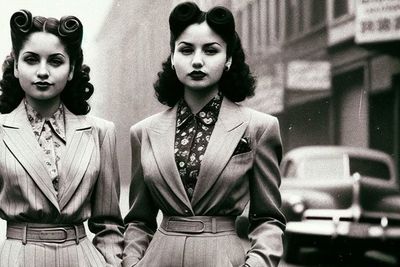Dressed to the nines, defying norms, dancing to the rhythm of jazz, and shaping a revolutionary subculture in the mid-20th century - this was the world of the Pachucas. Not merely fashion enthusiasts, but active proponents of change, these Mexican women boldly stepped onto the stage of cultural history. Let's take a time machine back to the 1940s to the birth of this iconic movement, and explore the legacy of the Pachucas.
The Birth of a Cultural Icon
The term 'Pachuca' is synonymous with young Mexican-American women who belonged to the Pachuco subculture, predominantly seen in the 1940s and 1950s. Pachucas were characterized by their distinctive style of dress and their defiance of conventional societal norms.
The Pachuca story begins against the backdrop of World War II, with the "Zoot Suit" riots in Los Angeles. The Zoot Suit, with its high waist, wide legs, and long coat, was the uniform of the Pachuco subculture. The suit was a rebellion against wartime fabric rationing, becoming a symbol of non-conformity and resistance.
The Pachucas adopted this style, adding their own feminine twist with pencil skirts, fishnet stockings, and platform heels. Although in many instances, they opted for wearing the same outfits as the men and wore their hair in high pompadours or styled in a "Victory Roll," further defying societal expectations of a woman's appearance at that time.
Pachucas didn't just push boundaries with their style; they did so with their dance as well. They embraced dances such as the jitterbug and swing, which originated in African American culture. This was a significant stand against racial segregation and discrimination prevalent in the 1940s.
Pachucas danced with confidence and control, often leading their partners, a role traditionally reserved for men. This direct challenge to the gender norms of the time further established the Pachuca as a symbol of rebellion.
The Pachuca movement was more than just about fashion and dance; it was a fight for identity. As Mexican-Americans, the Pachucas found themselves in a liminal space, caught between two cultures. They faced racial discrimination and were often ostracized for not fitting into the traditional Mexican or American female roles.
By embracing the Pachuca lifestyle, these women carved out a unique cultural space for themselves. They refused to be pigeonholed, instead creating a hybrid identity that celebrated both their Mexican heritage and American influence.
The Legacy of the Pachucas
The Pachuca movement left a lasting impression on the world. They were pioneers of their time, making waves in a society that often sought to keep them in their place. Their impact continues to resonate vividly within our modern society. In some cities, such as Los Angeles and Ciudad Juárez, this subculture is not just a page from a history book, but a living, breathing entity, proudly flaunting its continued vitality and strength.
The heart of this culture can be found in areas where Mexican-American populations are substantial, notably in the southwestern United States, such as California and Texas, and in parts of Mexico like Ciudad Juarez and Chihuahua.
Pachucos dancing in downtown Ciudad Juarez, Mexico.www.youtube.com
Los Angeles remains a bastion of Pachuco culture, evident in its enduring influence on the city's music, fashion, and art scenes. Events like the El Pachuco Zoot Suits fashion show or the annual Zoot Suit festival celebrate this distinct style and its cultural impact.
The resurgence of interest in vintage fashion and classic styles in recent years has also led to a renewed appreciation for the Pachuco and Pachuca aesthetic. Their style, a meld of Mexican and American influences, continues to inspire fashion designers today, echoing in the glamor of high fashion runways and the edge of street style.
The Pachucas also contributed significantly to the feminist and Chicano movements, demonstrating the intersectionality of race, gender, and class struggles. By rebelling against traditional gender norms and racial expectations, they paved the way for future activists. Their story has become a rallying cry for those who continue to fight for equality and representation; a powerful reminder of the power of resilience and resistance.
The Pachuca legacy continues to dance through the annals of history serving as a timeless reminder of the power of defiance, the beauty of individuality, and the enduring strength of cultural identity.
- The Lost History of the Adelitas of the Mexican Revolution ›
- Revolutionaries Reborn: The Story of Las Adelitas de Aztlan - Luz Media ›
- Chicano is Making a Comeback - Luz Media ›
- The History of Hoop Earrings Across Generations - Luz Media ›
- The Story of Juan Valdez: How Colombian Coffee Became Global - Luz Media ›
- The Unseen World of Latina Goths - Luz Media ›
